I felt enchanted by the colorful dots of this cake and the soft crumb that vanished with each bite. I still recall the lively chatter around the table and the sweet vanilla scent drifting through the air.
My earliest memories of baking involve me balancing on a stool, trying to peek into the mixing bowl while someone handed me a spoon. I have grown to appreciate how these cakes connect generations through shared stories. I treasure this particular recipe because it reminds me of my grandmother’s comforting presence.
I now recreate this Easter Polka Dot Cake every spring for my loved ones. The pastel polka dots brighten the table, and the gentle vanilla aroma sets the mood. I sometimes marvel at how a few ingredients can transform into something so cheerful.
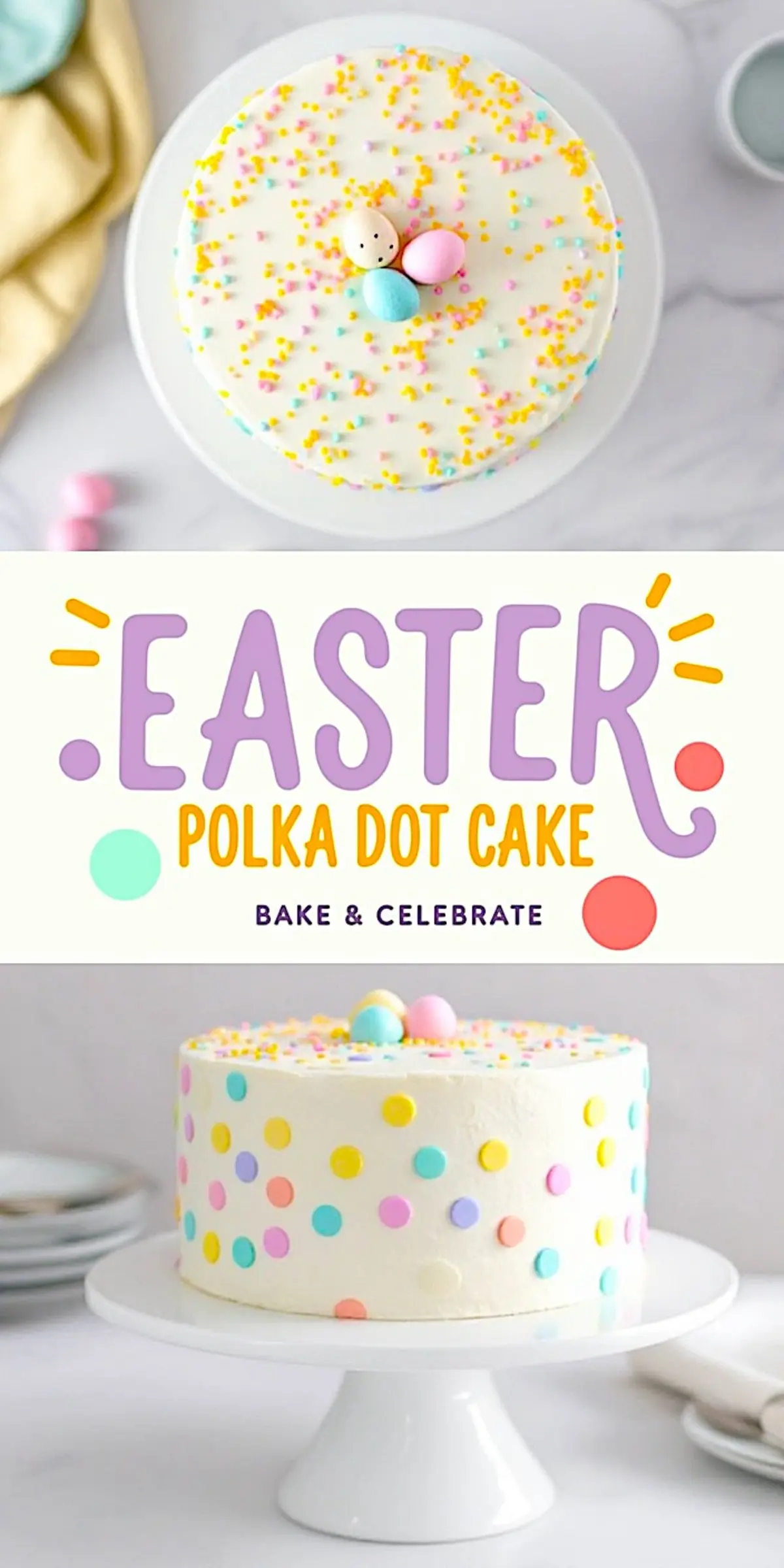
Easter Polka Dot Cake: A Colorful Tradition
I consider this dessert a symbol of spring festivity. There is a rich vanilla cake base that stands out with a smooth texture. A soft interior pleases everyone who takes a bite, and pastel dots add a playful twist that draws curious glances.
I use all-purpose flour, baking powder, salt, and a bit of sugar to lay the foundation for this indulgence. The combination of butter, eggs, and vanilla extract creates a moist, fragrant batter. I find that whole milk ties the flavors together without overpowering the sweetness.
I keep each step straightforward because too many complications can frustrate new bakers. This recipe follows a simple pattern: gather the dry ingredients, cream the butter and sugar, then combine everything gently with the milk.
Ingredients For A Vibrant Vanilla Creation

I follow a standard approach by preparing two bowls, one for the dry mix and one for the butter-sugar blend. My flour, baking powder, and salt often sit in a moderate mixing bowl. Butter and sugar then unite in a separate large bowl, whipped until they turn light and fluffy.
I add eggs individually, blending after each addition to keep the batter smooth. Vanilla extract comes next, infusing the mixture with a comforting aroma. The final step involves folding in the flour mixture and milk in intervals, which helps maintain a consistent texture.
I often double-check that each ingredient is at room temperature. Butter that is too cold or too soft can alter consistency, so I leave everything out on the counter for half an hour.
Mixing And Baking Each Layer
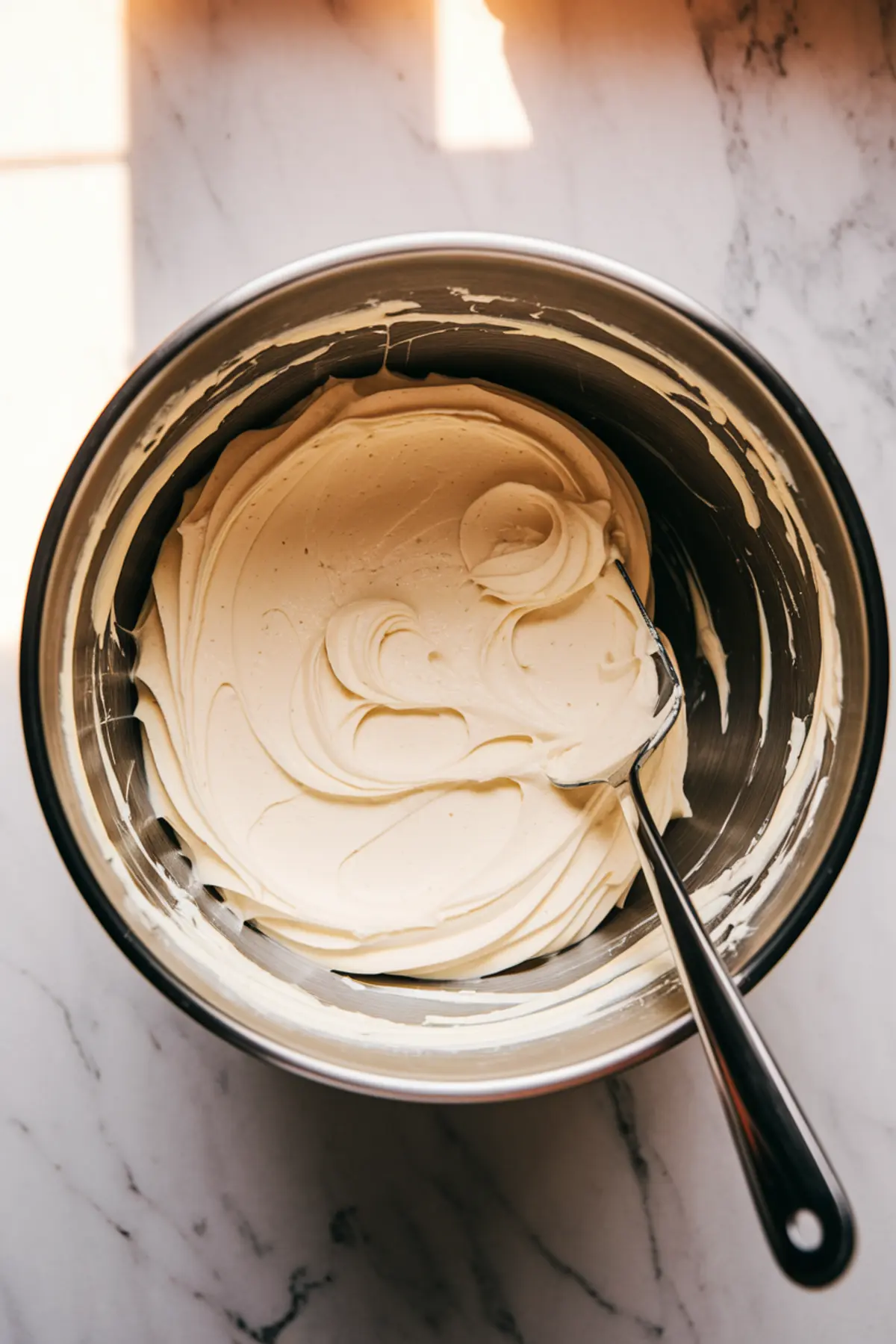
I preheat the oven to 350°F (175°C) and line my cake pans with parchment. My mother once forgot to line her pans, and the cake clung to the surface with unwavering determination. I learned from that mishap by carefully greasing and lining each pan.
I usually divide the batter equally, either by eye or by weighing each portion. A smooth, level surface helps produce even layers. Each layer bakes for approximately 30–35 minutes, or until a clean toothpick emerges from the center.
I cool the cakes in the pans for a short while, then move them to a wire rack so they can finish cooling thoroughly. A warm cake is difficult to frost, and the buttercream can slip off if any heat remains.
Creamy Buttercream That Brings Balance
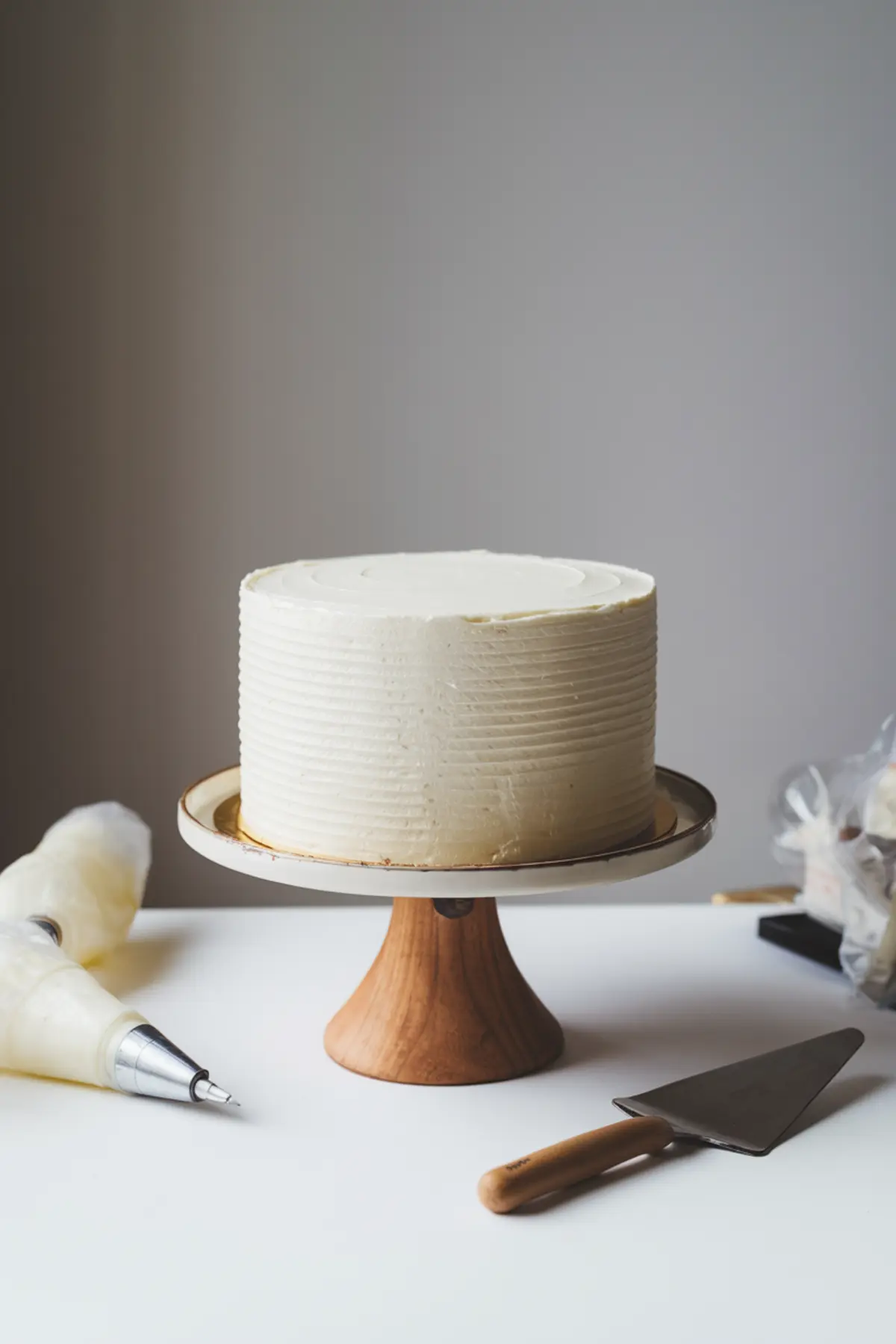
I make the frosting by beating softened butter until it appears airy. Powdered sugar enters the bowl next, added in increments to avoid a cloud of sugar taking over the kitchen. Vanilla extract and a tiny pinch of salt contribute extra depth.
I pour in a little heavy cream for silkiness, checking the texture as I go. This consistency should neither be too stiff nor too runny. My family tends to gather around the kitchen table at this point, eager to sneak a spoonful before I finish.
I recommend a taste test to determine if more sugar or an extra drop of vanilla is needed. The goal is a smooth spread that glides over the cake without fuss.
Shaping Fondant Polka Dots With Ease
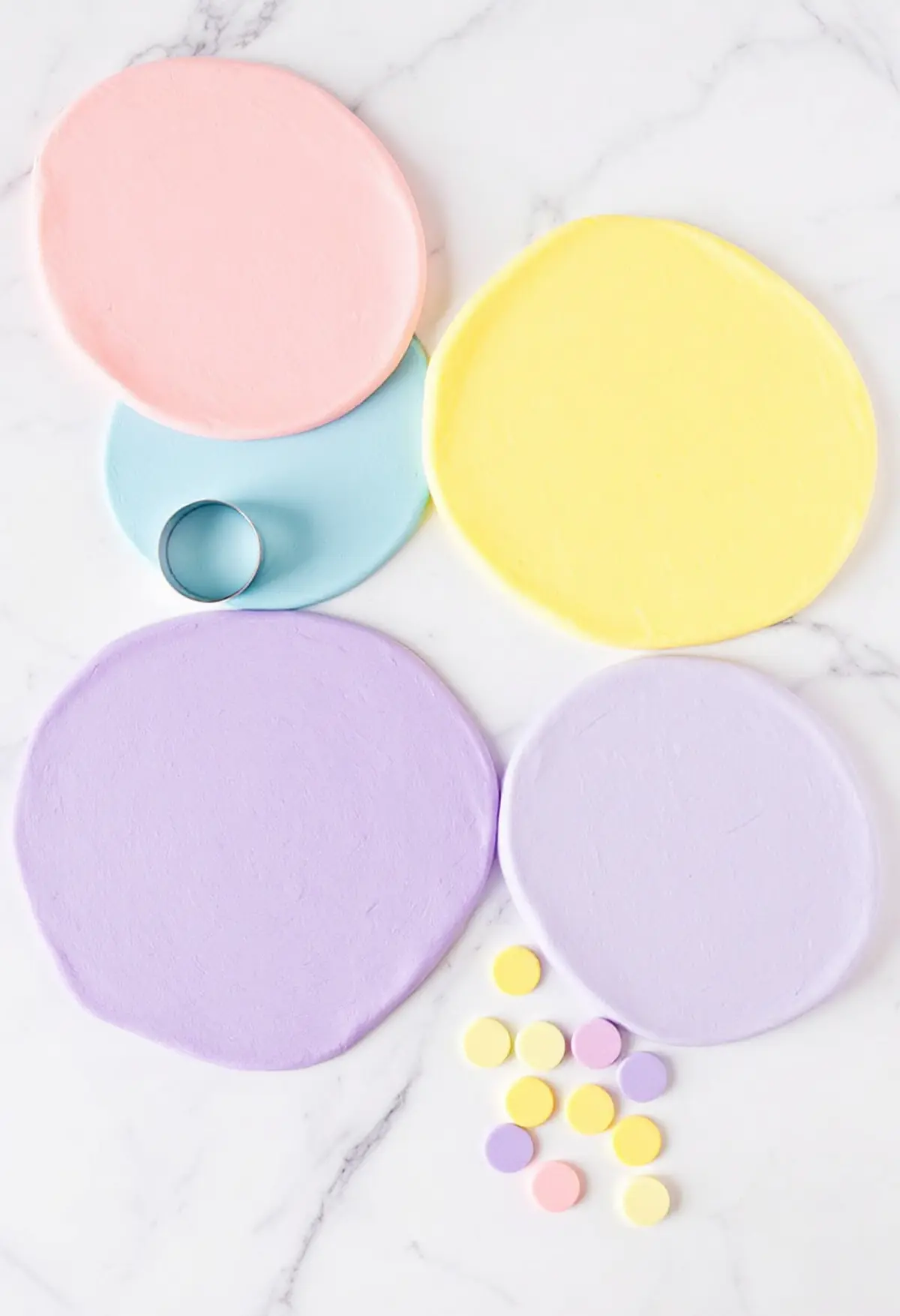
I tint my fondant pieces with pastel shades. A few drops of gel color are all I need. Pastels suit spring themes nicely, and the fondant remains pliable when handled carefully. I learned to dust the surface with cornstarch to prevent sticking.
I roll each colored portion to about one-eighth of an inch in thickness. Small round cutters or the end of a piping tip create circles in various sizes. They remind me of confetti, and that cheerful look livens up the finished cake.
I place these dots on parchment paper to dry slightly. If they become too stiff, I knead in a bit of shortening. Fondant can be finicky, but I maintain a relaxed pace and keep plastic wrap handy to seal any leftovers.
Frosting And Decorating With Confidence
I center one cooled cake layer on a serving plate. The first spread of buttercream covers the surface, creating a generous cushion for the second layer. A crumb coat then seals in stray bits before a brief rest in the fridge.
I retrieve the cake to coat it again, this time more carefully. An offset spatula glides over the surface with minimal effort. The pale frosting sets the stage for the pastel dots, which I press gently onto the cake’s sides.
I love how each colored circle seems to pop against the white buttercream. Sometimes I sprinkle extra confetti on top, which my children enthusiastically approve. The final look tends to draw smiles from everyone who sees it.
Easter Inspiration: More Sweet Ideas
I enjoy sharing holiday cakes with my family. If you adore this style, you might find inspiration in our Easter Bundt Cakefor a ring-shaped treat. A Speckled Egg Cake can brighten your dessert table with whimsical design. My Baby Chick Cake always sparks laughter among the little ones. An Easter Kit Kat Cake might tempt any fan of chocolate-coated crunch.
I have learned that color, shape, and flavor all work together to form delightful experiences. Each of these recipes delivers a cheerful sense of spring. I find variety welcoming, and my guests love exploring these playful presentations.
I suspect you might find your personal favorite by sampling them all over time. Different shapes and frostings keep every gathering interesting, and children appreciate the variety. That sense of joy is what keeps me baking year after year.
Share And Pin For Later
I hope my insights help you succeed with this colorful dessert. Let me know how your cake turns out, or pass on any tips you discover in the comments. I appreciate hearing stories about how families celebrate with something sweet on the table.
I also invite you to save this recipe on your Pinterest board for handy reference. My goal is to build a community of bakers who share treats and experiences with one another. Let’s keep our spring gatherings lively, one slice at a time.
I cherish each opportunity to bake this cake. My grandmother used to say that every celebration deserves a bit of color, and pastel polka dots do the trick. I trust that your cake will bring you many happy moments, just as it does for me.
Easter Polka Dot Cake Recipe
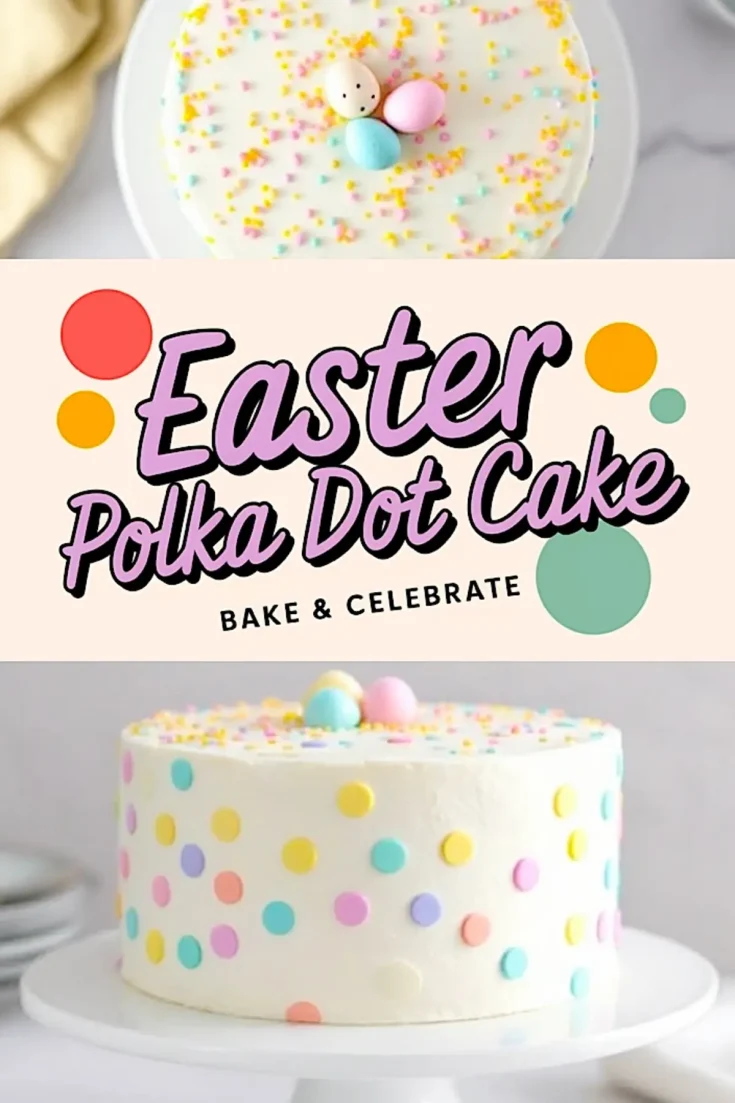
A colorful vanilla cake with smooth buttercream frosting and playful fondant polka dots in pastel colors. Each slice reveals a soft, tender crumb with a festive design, making it a fun dessert for spring celebrations.
Ingredients
- FOR THE VANILLA CAKE
- 2 ½ cups all-purpose flour
- 2 ½ teaspoons baking powder
- ½ teaspoon salt
- 1 cup unsalted butter, softened
- 2 cups granulated sugar
- 4 large eggs
- 1 tablespoon vanilla extract
- 1 cup whole milk
- FOR THE BUTTERCREAM FROSTING
- 1 ½ cups unsalted butter, softened
- 4 cups powdered sugar
- 2 tablespoons heavy cream (or milk)
- 2 teaspoons vanilla extract
- Pinch of salt
- FOR THE FONDANT POLKA DOT DECORATIONS
- 8 ounces white fondant
- Gel food coloring (pink, blue, yellow, purple)
- Cornstarch (for rolling)
Instructions
- PREPARE THE CAKE BATTER: Preheat the oven to 350°F (175°C). Grease and line two 8-inch round cake pans with parchment paper. In a medium bowl, whisk together the flour, baking powder, and salt. In a large mixing bowl, beat the butter and sugar until light and fluffy. Add the eggs one at a time, mixing well after each addition, then stir in the vanilla extract. Gradually add the dry ingredients, alternating with the milk, beginning and ending with the dry ingredients. Mix until just combined.
- BAKE THE CAKE LAYERS: Divide the batter evenly between the prepared cake pans and smooth the tops. Bake for 30–35 minutes, or until a toothpick inserted in the center comes out clean. Let the cakes cool in the pans for 10 minutes, then transfer them to a wire rack to cool completely.
- MAKE THE BUTTERCREAM FROSTING: In a large mixing bowl, beat the softened butter until smooth and creamy. Gradually add the powdered sugar, mixing well after each addition. Stir in the vanilla extract and a pinch of salt. Add heavy cream, one tablespoon at a time, until the frosting reaches a smooth, spreadable consistency.
- PREPARE THE FONDANT POLKA DOTS: Divide the white fondant into four equal portions. Tint each portion with a different pastel gel food coloring (pink, blue, yellow, and purple), kneading until the color is fully incorporated. Lightly dust a clean surface with cornstarch and roll out each colored fondant piece to about ⅛-inch thickness. Use small round cutters or the end of a piping tip to cut out fondant polka dots in different sizes. Set aside on a parchment-lined surface to slightly dry before applying.
- ASSEMBLE THE CAKE: Place one cooled cake layer on a cake stand or serving plate. Spread a layer of buttercream frosting evenly over the top. Place the second cake layer on top and apply a thin layer of frosting all over the cake for a crumb coat. Chill for 15 minutes. Apply the final layer of buttercream, smoothing it out with an offset spatula for a clean finish.
- DECORATE WITH FONDANT POLKA DOTS: Gently press the fondant polka dots onto the sides of the frosted cake in a random pattern, varying placement and sizes for a playful look. If desired, sprinkle the top with pastel confetti sprinkles for extra decoration.
Notes
Cake Texture: To achieve a soft and tender crumb, be careful not to overmix the batter. Mix only until the ingredients are fully combined to avoid a dense cake.
Even Cake Layers: Weigh the batter in each pan for uniform layers. This helps ensure even baking and a more balanced cake structure.
Butter Temperature: The butter for both the cake and frosting should be softened but not melted. If the butter is too warm, the cake may be greasy, and the frosting may become too loose. Let it sit at room temperature for about 30 minutes before using.
Fondant Handling: Fondant dries out quickly, so keep unused portions wrapped in plastic wrap while working. If fondant becomes too dry, knead in a small amount of vegetable shortening to restore elasticity.
Coloring the Fondant: Use gel food coloring instead of liquid food coloring to avoid altering the texture of the fondant. Knead the color thoroughly to ensure even distribution.
Rolling Fondant: Lightly dust the rolling surface with cornstarch to prevent sticking. If too much cornstarch is used, brush off excess with a dry pastry brush.
Applying Fondant Polka Dots: If the fondant circles do not stick easily to the buttercream, lightly dampen the back of each piece with a tiny bit of water before pressing it onto the cake.
Chilling Between Steps: Chilling the cake after applying the crumb coat helps set the frosting and makes it easier to apply the final layer smoothly. For the best results, chill for at least 15 minutes before adding the final coat of buttercream.
Storage: Store the finished cake in an airtight container at room temperature for up to two days or in the refrigerator for up to five days. If refrigerated, let the cake sit at room temperature for about 30 minutes before serving for the best texture.
Freezing: The cake layers can be baked in advance and frozen. Wrap each cooled cake layer tightly in plastic wrap and store them in an airtight container for up to three months. Thaw at room temperature before assembling and decorating.
Serving Tip: For clean slices, use a sharp knife and wipe the blade clean between cuts. This helps maintain neat edges and prevents excess frosting from smearing between layers.
Customization: Try using different pastel colors for the polka dots or adding additional decorations, such as piped buttercream details or edible pearls, for a more intricate design.
Nutrition Information
Yield
12Serving Size
1Amount Per Serving Calories 871Total Fat 43gSaturated Fat 26gTrans Fat 0gUnsaturated Fat 15gCholesterol 174mgSodium 258mgCarbohydrates 117gFiber 1gSugar 93gProtein 6g

